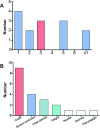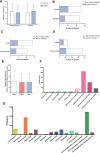Clinical Features for Severely and Critically Ill Patients with COVID-19 in Shandong: A Retrospective Cohort Study
- PMID: 33442256
- PMCID: PMC7797329
- DOI: 10.2147/TCRM.S280079
Clinical Features for Severely and Critically Ill Patients with COVID-19 in Shandong: A Retrospective Cohort Study
Abstract
Background: Severe acute respiratory syndrome coronavirus 2 (SARS-CoV-2), a novel pathogen, has caused an outbreak of coronavirus disease 2019 (COVID-19) that has spread rapidly around the world. Determining the risk factors for death and the differences in clinical features between severely ill and critically ill patients with SARS-CoV-2 pneumonia has become increasingly important.
Aim: This study was intended to provide insight into the difference between severely ill and critically ill patients with SARS-CoV-2 pneumonia.
Methods: In this retrospective, multicenter cohort study, we enrolled 62 seriously ill patients with SARS-CoV-2 pneumonia who had been diagnosed by March 12, 2020. Clinical data, laboratory indexes, chest images, and treatment strategies collected from routine medical records were compared between severely ill and critically ill patients. Univariate and multivariate logistic regression analyses were also conducted to identify the risk factors associated with the progression of patients with severe COVID-19.
Results: Of the 62 patients with severe or critical illness, including 7 who died, 30 (48%) patients had underlying diseases, of which the most common was cardiovascular disease (hypertension, 34%, and coronary heart disease, 5%). Compared to patients with severe disease, those with critical disease had distinctly higher white blood cell counts, procalcitonin levels, and D-dimer levels, and lower hemoglobin levels and lymphocyte counts. Multivariate regression showed that a lymphocyte count less than 109/L (odds ratio 20.92, 95% CI 1.76-248.18; p=0.02) at admission increased the risk of developing a critical illness.
Conclusion: Based on multivariate regression analysis, a lower lymphocyte count (<109/L) on admission is the most critical independent factor that is closely associated with an increased risk of progression to critical illness. Age, underlying diseases, especially hypertension and coronary heart disease, elevated D-dimer, decreased hemoglobin, and SOFA score, and APACH score also need to be taken into account for predicting disease progression. Blood cell counts and procalcitonin levels for the later secondary bacterial infection have a certain reference values.
Keywords: COVID-19; SARS-CoV-2; clinical features; critically ill patients; severely ill patients.
© 2021 Zhou et al.
Conflict of interest statement
The authors declare no conflicts of interest. The authors declare that they have no known competing financial interests or personal relationships that could have appeared to influence the work reported in this paper.
Figures



References
LinkOut - more resources
Full Text Sources
Other Literature Sources
Miscellaneous

